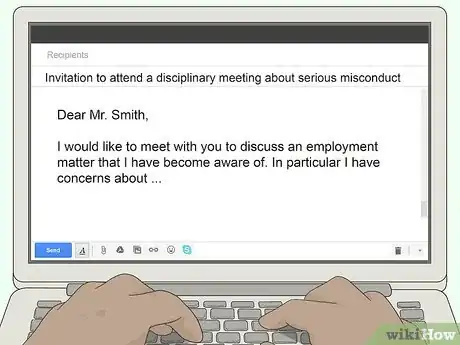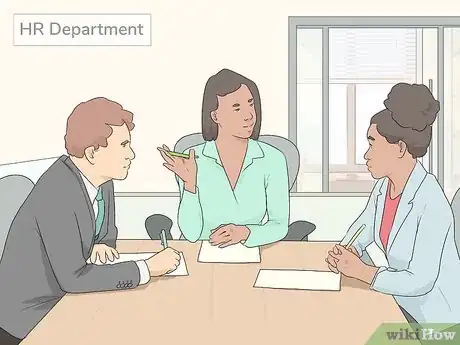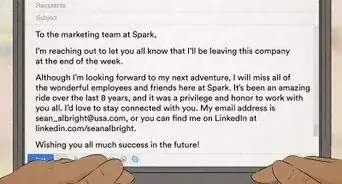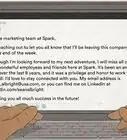This article was co-authored by Amber Rosenberg, PCC. Amber Rosenberg is a Professional Life Coach, Career Coach, and Executive Coach based in the San Francisco Bay Area. As the owner of Pacific Life Coach, she has 20+ years of coaching experience and a background in corporations, tech companies, and nonprofits. Amber trained with the Coaches Training Institute and is a member of the International Coaching Federation (ICF).
This article has been viewed 69,816 times.
If you have an employee whose behavior or performance is causing problems, you may be wondering how to handle the necessary disciplinary meeting. To help ensure the situation doesn't escalate, have a private meeting and explain the infraction and next steps as respectfully as possible. It can also help to brush up on your company's policies before you conduct the disciplinary meeting to make sure you're following company protocol. And don't worry—we're here with the tips you need to successfully handle an employee disciplinary hearing!
Steps
Calling a Disciplinary Meeting
-
1Conduct an investigation into the incident. Before you hold a disciplinary meeting for an employee, it's imperative that you thoroughly review the incident at hand. The investigation may entail interviewing other employees or witnesses for details on the incident. Make sure a representative from Human Resources is present during all interviews.[1]
- Ask anyone you interview to sign an accurately-written dictation of their statement.
- Compile and review the evidence for and against the employee. If the evidence overwhelmingly suggests that the employee was at fault, you'll need to proceed to disciplinary proceedings.
- Document everything that is said about the incident and about the employee, including by the employee himself or herself.[2]
- For minor infractions or first-time offenses, an informal, verbal warning is usually sufficient. For more serious infractions or repeat offenses, a formal disciplinary meeting may be called for.
-
2Keep the employee informed of the investigation. Your employee has a right to know that an investigation is being conducted and may lead to a disciplinary meeting. You do not want to withhold this information, as blindsiding an employee with disciplinary measures typically violates most companies' human resources policies.Advertisement
-
3Schedule a date, time, and location for the meeting. Once you've decided to proceed with a disciplinary meeting, you'll need to make arrangements for the actual meeting. Choose a date and time that is convenient for your schedule and is feasible for the employee's schedule (for example, at a time when the employee is scheduled to be in the office).
- The location of the meeting should be someplace private that will not be interrupted. Privacy is important for both following protocol and maintaining workplace morale.
-
4Give the employee written notice of the meeting. After you've reserved a location for the meeting and scheduled a date and time, you'll need to inform your employee. The employee's notice should be delivered in writing so that they have a written document that details the incident and the coming procedure.
- The notice should include the details of the allegation. It should also notify the employee of the date, time, and location of the disciplinary meeting, as well as any attendees who will be present.
- Depending on your employer's policies and the rules that pertain to disciplinary hearings, you may also be required to allow the employee to bring a union representative or work colleague. This should be mentioned in the written notice.
Holding the Meeting
-
1Have an HR representative present. It's best to have a representative from human resources (HR) present at any and all disciplinary meetings. This is beneficial to both the employee and to you as the manager.
- Employees may see an HR representative's presence as a form of protection against unfair disciplinary proceedings.
- As a manager, you may want an HR representative there to serve as a witness.
-
2Reiterate the allegations against the employee. It's best to begin the meeting by reminding the employee of what they did wrong. Whether it's a behavioral problem or a job performance issue, reviewing what happened and why it was a problem is an imperative first step in the disciplinary process.
- Be clear and complete in your summary of the allegations/infractions. Do not leave out any details, and make sure the employee understands what incident is being reviewed and why.
- If the allegations involve some infraction of the law, you may not be able to disclose all the details to the employee. This is particularly true if a criminal investigation is ongoing or pending.
- Consult with a police officer before proceeding if the employee is or may be under criminal investigation.
-
3Review the standards of conduct or performance. After reiterating the allegations against the employee, it's a good idea to contrast that behavior with the prescribed standards of conduct and performance at your company. This will help clarify what the employee did wrong and what should have been done differently. Reviewing the standards also helps protect management from any allegations that the employee was unclear on the rules. It reminds the employee that the rules are clearly written and available to all employees.[3]
-
4Outline the company's disciplinary policy. Now that the employee has been reminded of what should have been done differently and why, you'll want to inform the employee of what your company can legally do to reprimand that infraction. The employee should be clear on what management can and cannot do in response to the bad behavior, and you should lay out all of the disciplinary options available at your disposal.
- While you may not have arrived at a ruling on the matter, it's important that the employee understands what may end up happening after the proceedings.
- Reviewing the company's disciplinary policy also helps protect management from allegations of unfair treatment.
-
5Arrive at a decision. The decision in your disciplinary meeting will depend on the nature of your employee's infraction/misconduct as well as the disciplinary policy in place at your company. In general, minor infractions warrant minor disciplinary measures, while more serious infractions warrant more serious measures.
- Serious infractions may include theft, assault, or significant acts of insubordination.[4]
- Maintain the notes you take as you deliberate on a decision. These notes and any supporting documents from the investigation and meeting should be kept in either the employee's personnel file or in a secure, locked location.
-
6Inform the employee of your decision. Once you've arrived at a decision, you'll need to inform your employee about what will happen next. Depending on your company's policies, you may want to deliver the decision in writing to the employee, or at least offer a written explanation in addition to a verbal announcement.
- Keep the decision confidential. The only people you should tell are the employee, their union representative (if they have one), and the HR representative who served as a witness.
- If the employee is to be suspended, a short, follow-up suspension meeting should be scheduled.
- Different employers may have different disciplinary policies, but in general, a verbal warning is the first form of discipline. Verbal warnings are usually followed by written reprimands, suspension, and eventual termination.[5]
Following Up After the Meeting
-
1Inform the employee what to do differently. The goal of disciplinary proceedings is not to punish the employee so much as to correct bad behavior and performance issues. As such, you may need to give your employee some reminders from time to time on what they should be doing differently.[6]
- Give clear examples. Describe what should have been done differently in the incident that was investigated, and provide hypothetical examples of similar situations.
- Don't be overbearing and don't correct your employees in front of their coworkers. Assess the situation and ask to speak in private as needed.
-
2Monitor the employee's performance after the meeting. As time goes on, your employee should have learned from the disciplinary meeting. They should implement the changes you've recommended, and their behavior (whether good or bad) should be monitored over time.[7]
- Look for both improvements and future infractions. Praise the employee for corrected behavior, and give verbal input on behavior that still needs to be corrected.
-
3Arrange for follow-up meetings as needed. If the employee's behavior or performance does not change to meet the company's expectations, future conversations may be necessary with the employee. These conversations may lead to further disciplinary meetings, or they could be as simple as offering feedback and guidance, depending on the nature of the infraction and the employee's response to feedback.[8]
Expert Q&A
-
QuestionCan I ask a boss for a reference if they fired me?
 Amber Rosenberg, PCCAmber Rosenberg is a Professional Life Coach, Career Coach, and Executive Coach based in the San Francisco Bay Area. As the owner of Pacific Life Coach, she has 20+ years of coaching experience and a background in corporations, tech companies, and nonprofits. Amber trained with the Coaches Training Institute and is a member of the International Coaching Federation (ICF).
Amber Rosenberg, PCCAmber Rosenberg is a Professional Life Coach, Career Coach, and Executive Coach based in the San Francisco Bay Area. As the owner of Pacific Life Coach, she has 20+ years of coaching experience and a background in corporations, tech companies, and nonprofits. Amber trained with the Coaches Training Institute and is a member of the International Coaching Federation (ICF).
Pacific Life Coach If they let you go because the company was struggling or cutting back and you maintained a healthy relationship with that boss, there's no reason you can't ask for a reference. If things got a little heated or you violated some policy and upset your boss, it may be better to just let it go. Look elsewhere for your references if this is the case.
If they let you go because the company was struggling or cutting back and you maintained a healthy relationship with that boss, there's no reason you can't ask for a reference. If things got a little heated or you violated some policy and upset your boss, it may be better to just let it go. Look elsewhere for your references if this is the case.
References
- ↑ http://www.gsa.ac.uk/media/932377/Disciplinary-and-Perf-Mgt-PandP.pdf
- ↑ https://www.entrepreneur.com/article/78508
- ↑ http://www.hr.uwa.edu.au/policies/policies/management/performance
- ↑ http://www.hr.gov.nt.ca/human-resource-manual/0700-discipline/0701-employee-discipline
- ↑ http://www.hr.gov.nt.ca/human-resource-manual/0700-discipline/0701-employee-discipline
- ↑ http://www.hr.uwa.edu.au/policies/policies/management/performance
- ↑ http://www.hr.uwa.edu.au/policies/policies/management/performance
- ↑ http://www.hr.uwa.edu.au/policies/policies/management/performance
About This Article
Managing a disciplinary meeting can be stressful, but if you remain professional, it should go smoothly. Have a representative from Human Resources present for the meeting to serve as a witness. Start the meeting by reminding the employee of the specific allegations made against them. Then, contrast their behavior with your standards of conduct so they can see what they should have done. Tell them the company’s disciplinary policy for their infraction and the decision you’ve arrived at. Try to act only on the evidence you have to avoid being biased by any personal feelings. If the employee gets annoyed or is unapologetic, stay calm and professional. You should also keep notes from the meeting so you can file these with your disciplinary records. For more tips, including how to monitor your employee’s performance after the disciplinary meeting, read on!









































































